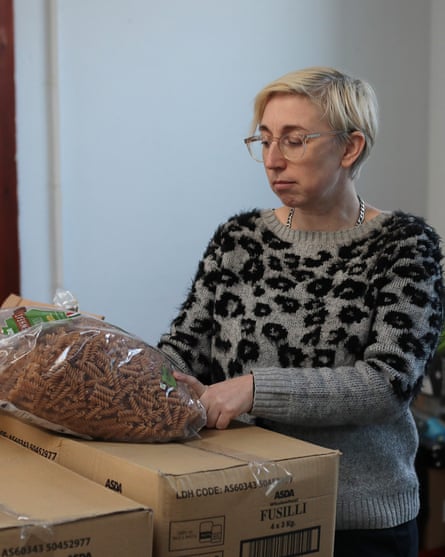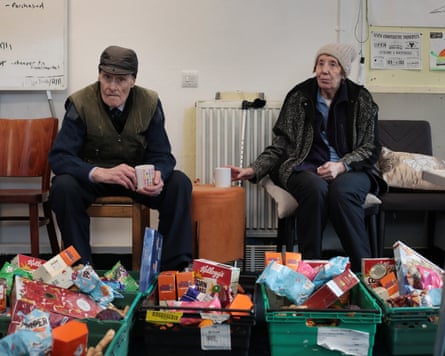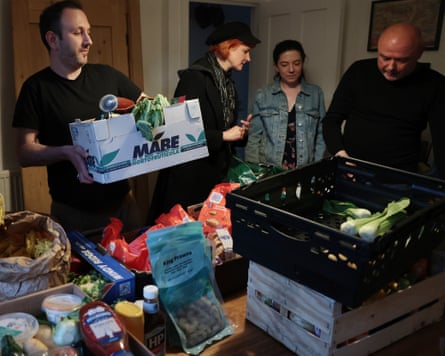Most people would jump at the chance to save up to 40% – and more in some cases – on their food shopping each week.
Yet if it meant discarding speed and convenience in favour of old-fashioned ideas such as knocking on doors and collaborating with the neighbours, would that enthusiasm remain?
As far as the not-for-profit food co-op Cooperation Town is concerned, the answer is yes – people just need encouragement.
Launched in 2019 on an estate in Kentish Town in north London with the aim of promoting solidarity in place of charity, its founders quickly discovered demand was high.
Cooperation Town has since gone from strength to strength. It is now helping more than 30 community UK food co-ops to buy wholesale and acquire surplus groceries from businesses to feed themselves at a significant discount.
Everyone typically chips in £3 to £6 a week and the economies of scale help to make that collective pot go much further.

A few months ago, intrigued by the concept and the potential savings that could be made, I approached Shiri Shalmy, one of the co-founders of Cooperation Town, to talk about setting up my own food co-op. Much as I liked the idea, I wondered how easy it would be to agree on what food to order and I also felt unsure about the time commitment.
“Not everyone will get everything they want,” Shalmy told me. “But most people will get everything they need. The specialist stuff, you go to the shop for. I do that because I can’t expect 20 other households to want the same type of dessert that I like. But it turns out most people, no matter where you are in the world, eat rice, pasta, fresh fruit and vegetables.”
As for the time commitment, Shalmy said most co-ops ran smoothly and were simple to manage so long as everyone shared the work.
The biggest hurdle to creating a food co-op is the initial time and effort involved in setting it up and finding like-minded people. Shalmy recommends keeping things small for the sake of convenience, with the aim of involving perhaps 15 to 20 neighbours and encouraging the development of a separate co-op if more want to join.
Shalmy is adamant about one core principle: there is no substitute for knocking on doors and talking to people directly.

So, over a period of about two weeks, I found an hour here and there to approach my immediate neighbours. Armed with some Cooperation Town leaflets and a quick spiel about the potential savings, I spoke to people to gauge interest.
The response was generally positive. After posting in a local WhatsApp group and asking a few friends who live close by too, I soon had about 13 people willing to give it a try.
From there, I arranged some meetings to discuss the general idea and air any reservations. Probably the biggest obstacle was finding one evening in the week when 10 to 12 people could all attend.
In the end, we hosted several meetings for different groups. I sat in on some to explain what had been discussed in the previous meeting, or shared notes so the next group knew what had been discussed and agreed.
We quickly decided to fill in a spreadsheet with the foods we all regularly buy in order to gain a sense of any crossovers and what our first order might look like. It did not take long to realise we all eat roughly the same fruit and vegetables on a more or less weekly basis.
Cooperation Town has an online starter pack that runs through a lot of frequently asked questions and its website is loaded with other resources such as a proposed agenda for a co-op’s first meeting, a template for a weekly shopping list and an example of a co-op constitution.

The organisation recognises that no one wants to sit through long and boring meetings, but also stresses that “consent decision-making” is the most equitable way of reaching decisions. Proposals are raised and discussed until everyone is happy and no one has a strong objection. This is not the fastest way to organise, but it ensures everyone’s needs are being met.
In my co-op, we debated whether to buy store-cupboard items such as rice and tinned tomatoes on an irregular basis, or focus on more frequent orders of perishable items. When I looked into the prices offered by wholesalers such as Costco and Booker, I found that buying bulk packages of rice or pasta was not all that cheaper – about 89p for 500g of basmati rice, for example – than buying individual packets of own-brand supermarket products.
Instead, the real value seemed to be in buying large boxes of seasonal produce from wholesale grocers. At this time of year, a 500g packet of cherry tomatoes that could cost £1 to £2 in a supermarket is about 60p when buying in bulk.
At the time of writing my co-op has 11 members and for our first order everyone chipped in £5.64 each. That sum is not fixed – it would depend on how much fruit and veg we wanted for a particular shop.
When we collected our order from Cooperation Town’s hub in north-west London, the quantity of food we were given was hard to believe. Thanks to donations of surplus food from redistribution charities such as the Felix Project, we were handed entire crates of cauliflowers, pak choi, potatoes and parsnips, along with lots of supermarket hummus, grated cheese, king prawns, cakes, biscuits and other store-cupboard items.

For a contribution of just over £5, every household was easily getting more than £40 worth of food. So on this occasion, you could argue we were saving a lot more than 40% on our usual weekly shop.
My co-op is lucky enough to have someone who drives, which meant we could also avoid an additional £10 delivery fee from the wholesale grocer and collect our order from Cooperation Town’s hub. (I’m not sure if other grocers charge the same, but I imagine it’s is probably fairly representative.)
I wondered if the delivery fee might be an obstacle for other people trying to set up a food co-op, but Shalmy says: “People measure value in different ways. This is a huge help for people on a lower income. If you don’t have a car, going to three shops on the bus is a huge job.
“The main obstacle is that people are not used to co-operating. We’ve been socialised to be insular and a bit suspicious of our neighbours.”
But with cost-of-living pressures continuing to squeeze household budgets – three in four Britons have reported an increase in their typical household grocery spend over the past year, according to a recent Ipsos poll – perhaps things are starting to change.
How to set up a food co-op

-
Knock on doors, chat to neighbours and talk to friends.
-
Find a space to hold meetings: it could be a village hall, someone’s home or via video conferencing.
-
Hold a founding meeting where everyone can ask questions and discuss what they want to achieve.
-
Divide jobs equally so no individual is shouldering too much responsibility.
-
Use a spreadsheet to help get a sense of the food you all tend to buy.
-
Don’t be afraid to try new things. If some people want to order an item you haven’t tried before – cassava, for example – share recipes and learn from one another.
-
Decide how to collect everyone’s weekly payments. It could be in cash, or you may want to use an app.
-
Approach local businesses to ask about surplus food and get in touch with wholesalers to ask about bulk buying.
-
Find a location where people can collect their orders. This can be someone’s home or, even better, a public space with storage that is accessible throughout the day.
-
Check out the website of Cooperation Town – a network of community food co-ops. The site has stacks of resources including a proposed agenda for a founding meeting, a template for a weekly shopping list, a template letter asking local businesses if they can help and an example of a wholesale fruit and vegetable list.

 3 months ago
82
3 months ago
82

















































